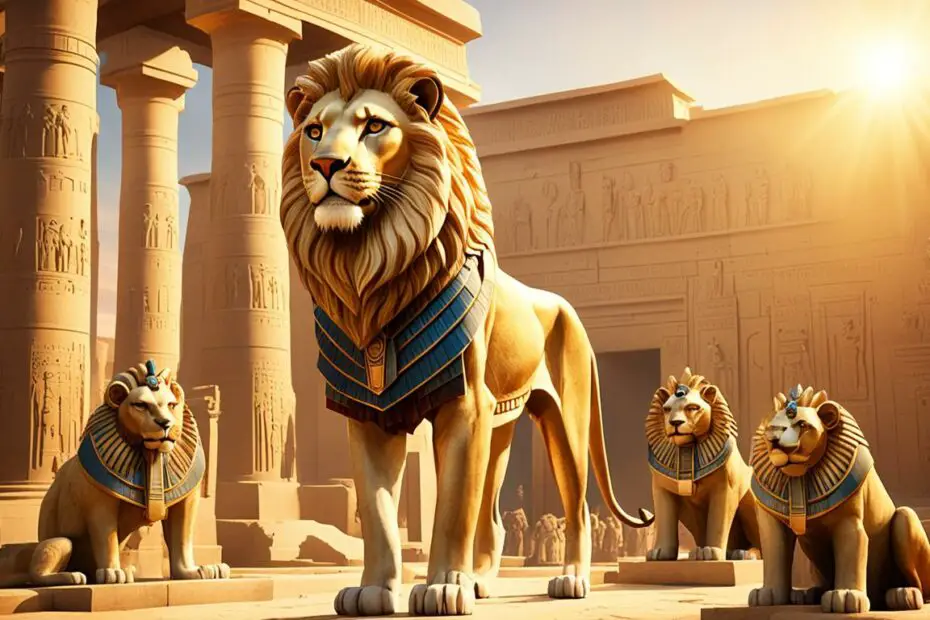Did you know that animals played a crucial role in the ancient Egyptian civilization? These animals were not just ordinary creatures, but rather revered as sacred symbols deeply embedded in both religious and secular contexts. From cats to crocodiles, ibises to baboons, each animal held significant meaning and was worshipped as a manifestation of gods and goddesses.
In this article, we will delve into the fascinating world of animals in ancient Egypt, exploring their symbolism, worship, and cultural importance. We will uncover the secrets behind their revered status, the rituals and mummification practices associated with them, and the legacy they have left behind in ancient Egyptian art and culture.
So, are you ready to embark on a journey back in time and unravel the mysteries of these sacred creatures? Let’s begin!
Role of Animals in Ancient Egyptian Religion and Culture
Animals played diverse roles in ancient Egyptian religion and culture. They were worshipped as gods and goddesses, with each deity often associated with a specific animal. The sacred animals held significant symbolism and were revered for their unique qualities.
One of the most prominent examples is the cat, which was associated with the goddess Bastet. Cats were regarded as protectors and brought good luck to their owners. They were often depicted in ancient Egyptian art, showcasing their importance in society.
The crocodile was another animal that held great significance. It represented the god of water and was a symbol of pharaonic power. The worship of crocodiles was prevalent, and they were often the subjects of rituals and offerings.
In addition to their specific associations, animals in general were revered for their protective qualities. They were believed to possess the power to ward off evil spirits and bring good fortune to their worshippers.
This reverence for sacred animals was an integral part of ancient Egyptian religious rituals. Offerings were made to the gods as a sign of devotion and to seek their blessings. These offerings often included the mummified remains of animals, an indication of the importance placed on the role of animals in religious practices.
Animal Associations with Deities
| Animal | Deity |
|---|---|
| Cat | Bastet |
| Crocodile | God of water |
| Ibis | Thoth |
| Baboon | Ra |
Animals in ancient Egyptian culture held a unique place of honor and reverence. They were not only revered as gods and goddesses but were also integral to religious practices and rituals. The rich symbolism and profound significance attached to these sacred animals highlight the intricate relationship between humans and animals in ancient Egypt.
Symbolism and Importance of Cats in Ancient Egypt
Cats held a special place in ancient Egyptian society. They were believed to embody qualities such as agility, grace, and protection, making them highly valued as pets and symbols of divinity. The goddess Bastet, often depicted as a lioness or with the head of a lioness, was associated with cats and revered as the protector of children and the deity of fertility. Cats were mummified and buried with their owners, and the discovery of the “Cemetery of Cats” in Saqqara revealed the extent of the ancient Egyptians’ reverence for these animals.
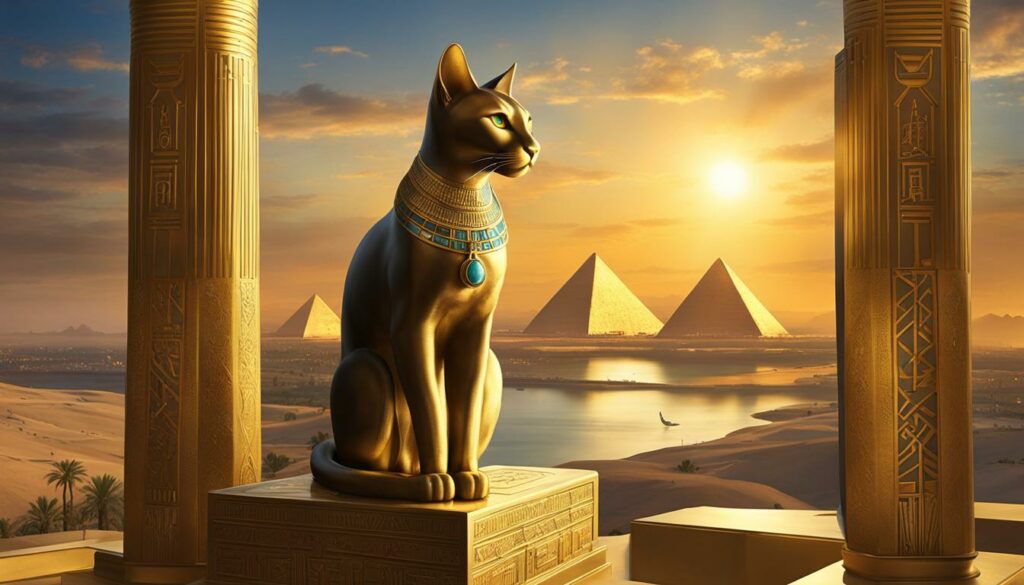
| Cat Symbolism in Ancient Egypt | Importance |
|---|---|
| Agility and Grace | Cats were admired for their agile movements and graceful demeanor, symbolizing elegance and poise. |
| Protection | Believed to possess protective qualities, cats were seen as guardians against evil spirits and bad luck. |
| Connection to the Divine | The goddess Bastet, associated with cats, represented fertility, motherhood, and feminine power. |
| Idolized as Divine Creatures | The ancient Egyptians associated cats with divinity and worshipped them as manifestations of the goddess. |
The Significance of Ibis and Baboons in Ancient Egyptian Beliefs
In ancient Egyptian beliefs, the ibis and baboons held significant roles, representing connections to the divine. Thoth, the god of writing and wisdom, was often depicted as an ibis-headed man and revered as the patron of knowledge and measurement. The ibis, with its long curved beak, signified the hieroglyphic representation of Thoth. The image of an ibis perched on a stand was a common symbol associated with this god.
Baboons, on the other hand, were closely linked to the sun god Ra. Due to their behavior of basking in the sun and their expressive mannerisms, they were believed to communicate directly with Ra. It was thought that their jubilant posturing and adoration of the sun represented their direct connection to the divine power of Ra. This association elevated baboons to a revered status in ancient Egyptian culture.
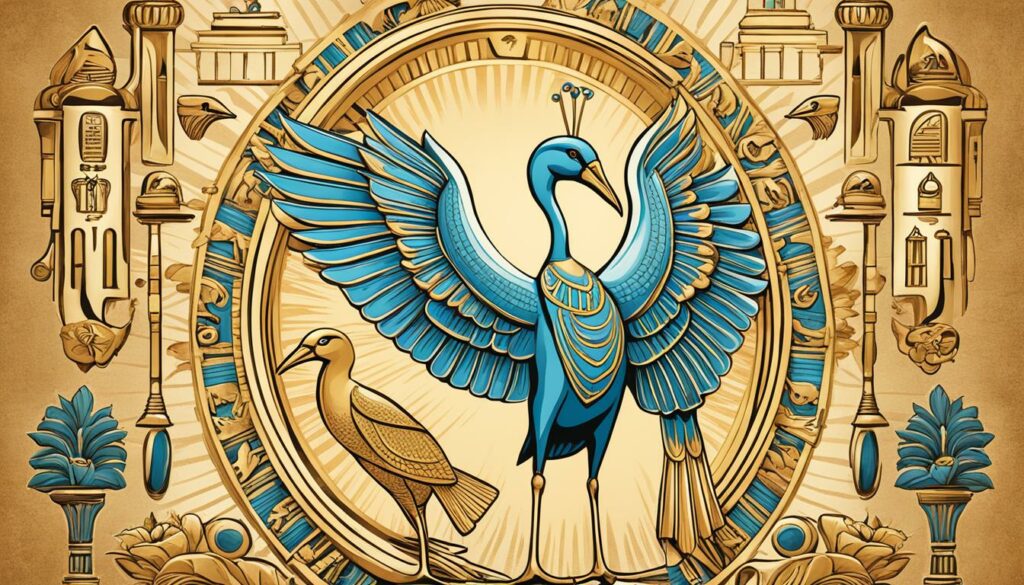
The importance of these animal symbols in ancient Egyptian beliefs can be seen in their depiction in art, hieroglyphs, and religious rituals. The ibis and baboons served as intermediaries between humans and the gods, embodying the spiritual qualities associated with Thoth and Ra, respectively.
Ibis and Baboon Symbolism in Ancient Egyptian Art
Ancient Egyptian art often showcased the symbolism of ibises and baboons. Paintings, reliefs, and statues depicted these creatures in various poses and settings, emphasizing their connection to the gods and their divine attributes. The art not only reflected the religious beliefs of the ancient Egyptians but also highlighted the important roles these animals played in their spiritual practices.
Symbolism of Ibis and Baboons in Ancient Egyptian Beliefs
| Ibis Symbolism | Baboon Symbolism |
|---|---|
| Representation of Thoth, the god of writing and wisdom | Associated with the sun god Ra |
| Patron of knowledge and measurement | Communication with the divine |
| Hieroglyphic sign for Thoth | Expression of jubilance and adoration towards the sun |
Please note that this table provides a summary of the symbolism associated with ibises and baboons in ancient Egyptian beliefs. The full breadth and depth of their significance can be explored through further research and study of ancient Egyptian culture and religious practices.
Animal Burial and Mummification in Ancient Egypt
Animal burial and mummification were common practices in ancient Egypt, particularly for sacred animals. These animals, including cats, ibises, crocodiles, and baboons, held significant religious and cultural importance and were often offered as gifts to the gods.
The Saqqara necropolis in northern Egypt is known for housing thousands of mummified cat remains, which are closely associated with the worship of the goddess Bastet. The area surrounding the Temple of Bastet became a final resting place for countless feline companions, symbolizing the sacred bond between the goddess and her beloved cats.
In addition to cats, other animals were also mummified and buried in large numbers. The process of mummification involved carefully preserving the animals’ bodies through a combination of embalming, wrapping in linen, and placing them in elaborately decorated coffins or sarcophagi. These mummified animals were often buried in dedicated animal cemeteries or within the premises of temples, where they would serve as permanent offerings to the gods.
To meet the demand for mummified animals, the ancient Egyptians bred certain species specifically for the purpose of mummification. These animals were raised in large numbers and underwent the mummification process before being sold or offered as sacred gifts.
Mummified Animal Offerings
| Animal | Mummification Process | Significance |
|---|---|---|
| Cats | Meticulous embalming, wrapping in linen, and burial with offerings | Symbolized the divine connection and protected against evil influences |
| Ibises | Embalming and burial with offerings | Associated with the god Thoth, patron of knowledge and writing |
| Crocodiles | Large-scale embalming and mummification; burial in specialized crocodile tombs | Represented the god of water and symbolized pharaonic power |
| Baboons | Embalming and burial with offerings | Believed to communicate with the sun god Ra |
The practice of mummifying animals also extended beyond the borders of Egypt. During the 19th century, mummified animals, including sacred ones, were exported to Europe, where they were used as fertilizers in agriculture due to their high nitrogen content.
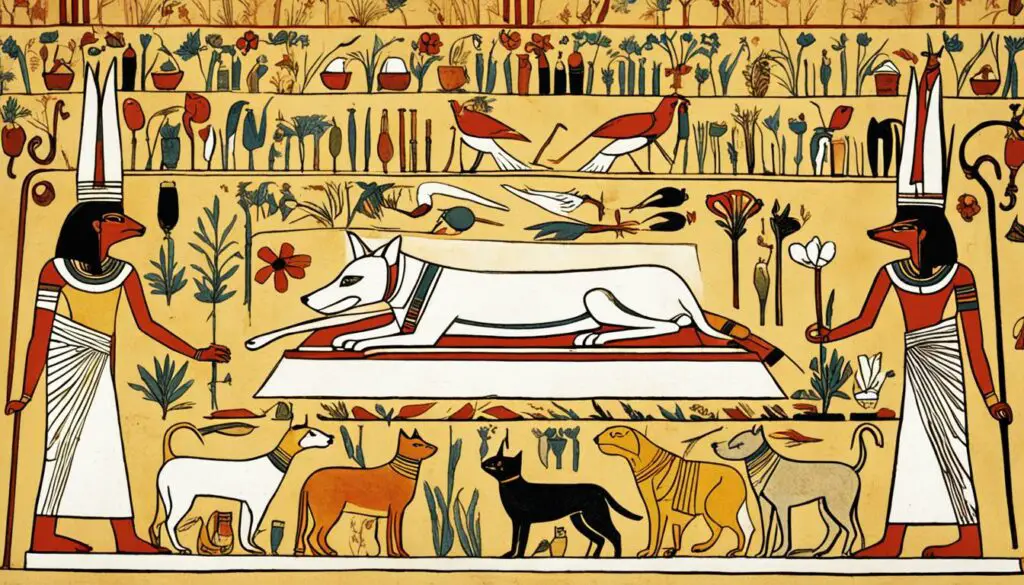
Next, let’s explore the depiction of animals in ancient Egyptian art to further understand their symbolic representation in the culture.
Depiction of Animals in Ancient Egyptian Art
Animals held great significance in ancient Egyptian culture, and their symbolic representations were prominent in the art of the time. Paintings, reliefs, statues, and jewelry showcased various animals, each with its own symbolic meaning. Among the animals commonly depicted in ancient Egyptian art were cats, crocodiles, ibises, and baboons. These artistic representations aimed to convey the qualities and traits associated with each animal, as well as their connections to the divine.
One notable example is the depiction of cats, which were revered for their agility, grace, and protective qualities. These feline creatures were often presented as representations of the goddess Bastet, who was the deity of fertility and the protector of children. Cats were frequently shown in reliefs and paintings alongside human figures, emphasizing their role as divine companions.
Another animal commonly depicted in ancient Egyptian art was the crocodile. The crocodile symbolized pharaonic power and was associated with the god of water. Its depiction in art showcased the strength and authority of the pharaoh. Images of crocodiles adorned temple walls and objects, reinforcing the connection between the pharaoh’s rule and the divine world.
The ibis, with its distinctive curved beak, was also a significant animal in ancient Egyptian art. It represented the god Thoth, the patron of writing and wisdom. Often depicted as an ibis-headed man, Thoth was believed to possess immense knowledge and was revered as a divine scribe. The inclusion of ibis symbols in artwork conveyed the importance of education and intellectual pursuits in ancient Egyptian society.
Baboons, characterized by their distinctive facial features, were another animal frequently depicted in ancient Egyptian art. They were associated with the sun god Ra and were believed to have a direct connection to the divine. Depictions of baboons adoring the sun showcased their jubilant communication with Ra and emphasized their role as intermediaries between the human and divine realms.
These representations of animals in ancient Egyptian art not only served as aesthetic expressions but also conveyed important cultural and religious messages. They reflected the ancient Egyptians’ belief in the divine qualities of animals and their interconnectedness with the gods. Through art, the symbolic significance of these animals was perpetuated and celebrated.
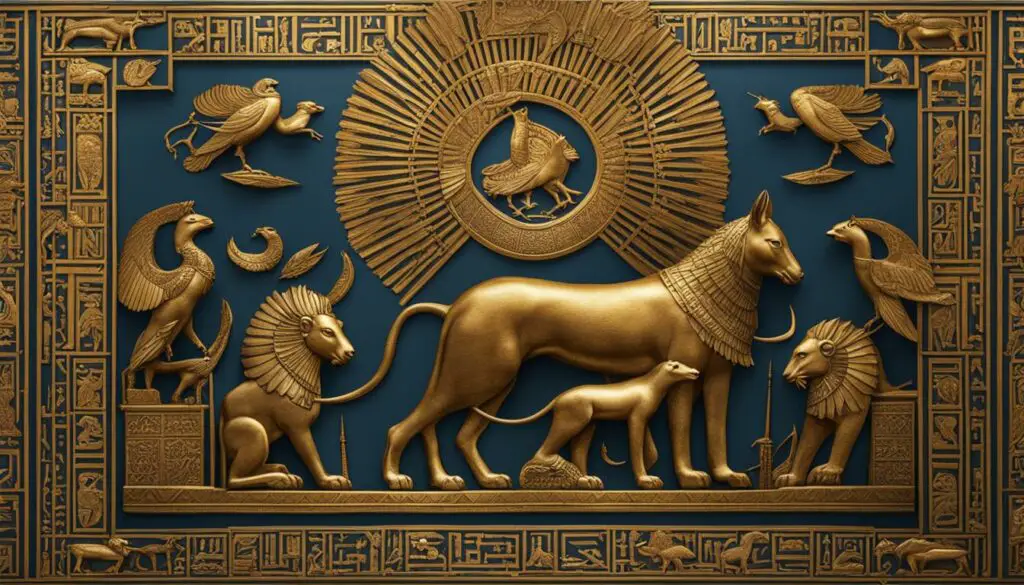
| Animal | Symbolic Meaning |
|---|---|
| Cat | Agility, grace, protection |
| Crocodile | Pharaonic power, divine authority |
| Ibis | Knowledge, wisdom |
| Baboon | Connection to the divine, intermediaries |
The Legacy of Animals in Ancient Egyptian Culture
The ancient Egyptians revered animals and their worship, burial practices, and artistic representations offer valuable insights into their religious beliefs and cultural values. The profound role that animals played in shaping ancient Egyptian civilization is evident through the veneration and presence of these creatures in their society. The remnants of animal mummies and artistic depictions serve as a powerful reminder of the intricate and complex relationship between humans and animals in this ancient civilization.
Ancient Egyptian animal worship was a significant aspect of their religious practices. Animals were regarded as manifestations of gods and goddesses, and their characteristics were believed to embody the nature of these deities. The worship of sacred animals played a central role in religious rituals, with each animal representing a specific god or goddess. This worship was a way for the ancient Egyptians to express their devotion and seek divine favor.
Another notable practice in ancient Egyptian culture was the burial of animals. Animals such as cats, ibises, crocodiles, and baboons were mummified and buried in large numbers as offerings to the gods. The Saqqara necropolis, located in northern Egypt, is known for its thousands of mummified cat remains associated with the Temple of Bastet. Animals were also specifically bred for mummification offerings, with their mummies even being exported to Europe in the 19th century for agricultural use.
Ancient Egyptian art further exemplifies the significance of animals in their culture. Paintings, reliefs, statues, and jewelry depicted animals such as cats, crocodiles, ibises, and baboons, highlighting their symbolic meaning. These artistic representations aimed to convey the unique qualities and traits associated with each animal, as well as their divine counterparts. Such art is a testament to the ancient Egyptians’ deep reverence for animals and their belief in the animals’ connection to the gods.
FAQ
Q: What animals were considered sacred in ancient Egypt?
A: Animals such as cats, crocodiles, ibises, and baboons were considered sacred in ancient Egypt.
Q: What was the role of animals in ancient Egyptian religion and culture?
A: Animals played diverse roles in ancient Egyptian religion and culture, including being worshipped as gods and goddesses and revered for their protective qualities.
Q: What was the significance of cats in ancient Egypt?
A: Cats held a special place in ancient Egyptian society and were associated with the goddess Bastet, revered as the protector of children and the deity of fertility.
Q: What were the roles of ibises and baboons in ancient Egyptian beliefs?
A: Ibis was associated with Thoth, the god of writing and wisdom, while baboons were believed to have a direct connection to the sun god Ra.
Q: What were the practices of animal burial and mummification in ancient Egypt?
A: Animal burial and mummification were common practices in ancient Egypt, especially for sacred animals like cats, ibises, crocodiles, and baboons, which were offered as gifts to the gods and buried in large numbers.
Q: How were animals depicted in ancient Egyptian art?
A: Animals were frequently depicted in ancient Egyptian art, showcasing their symbolic significance in the culture through paintings, reliefs, statues, and jewelry.
Q: What is the legacy of animals in ancient Egyptian culture?
A: The worship, burial practices, and artistic representations of animals provide insights into the religious beliefs and cultural values of ancient Egyptians, highlighting the profound role these creatures played in shaping their civilization.
